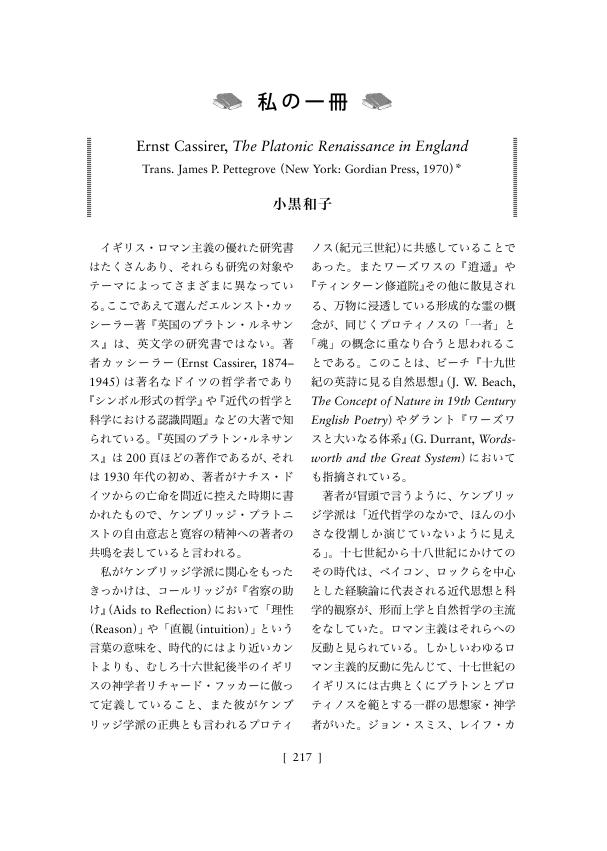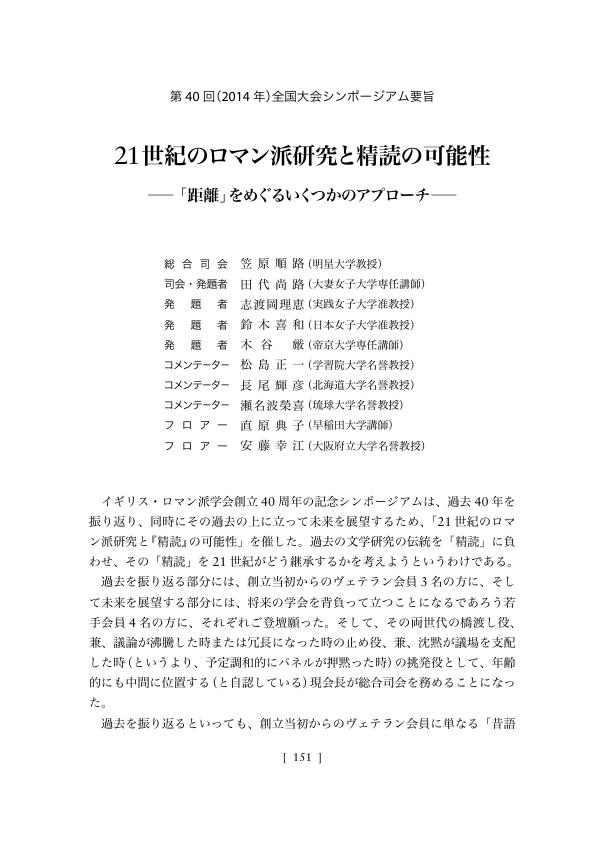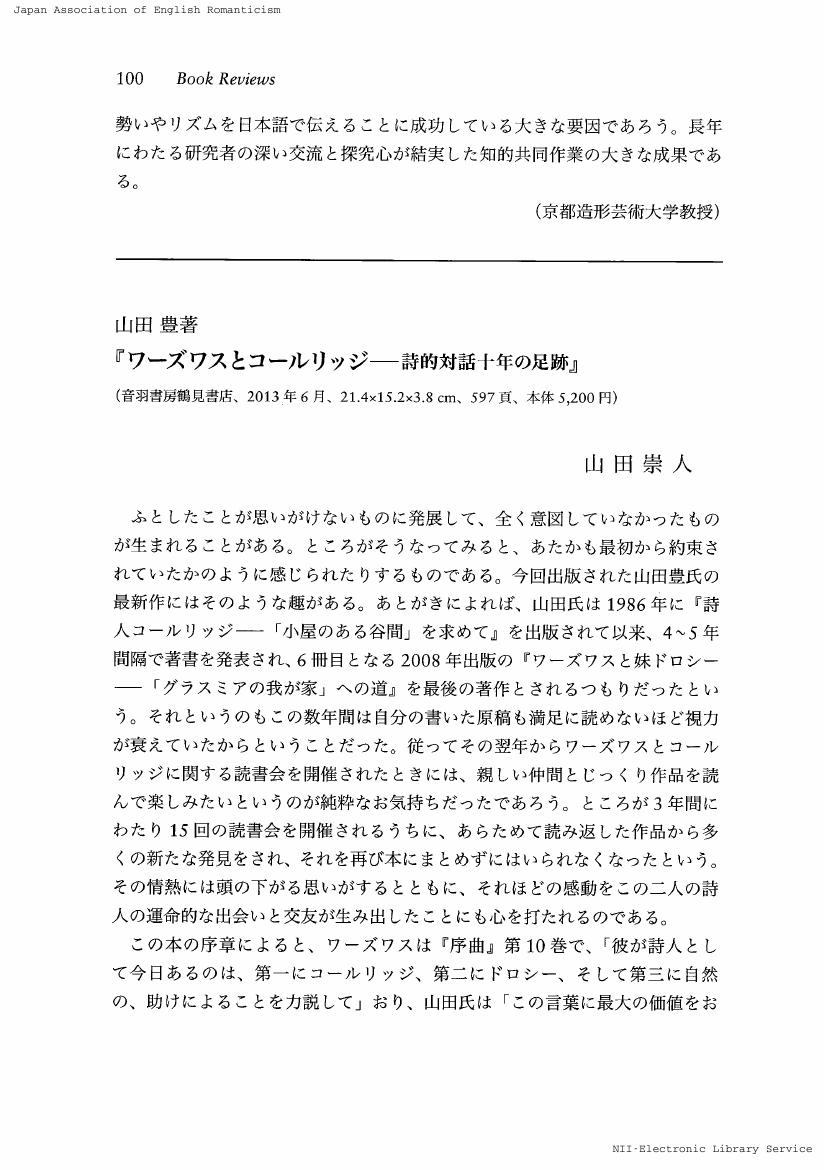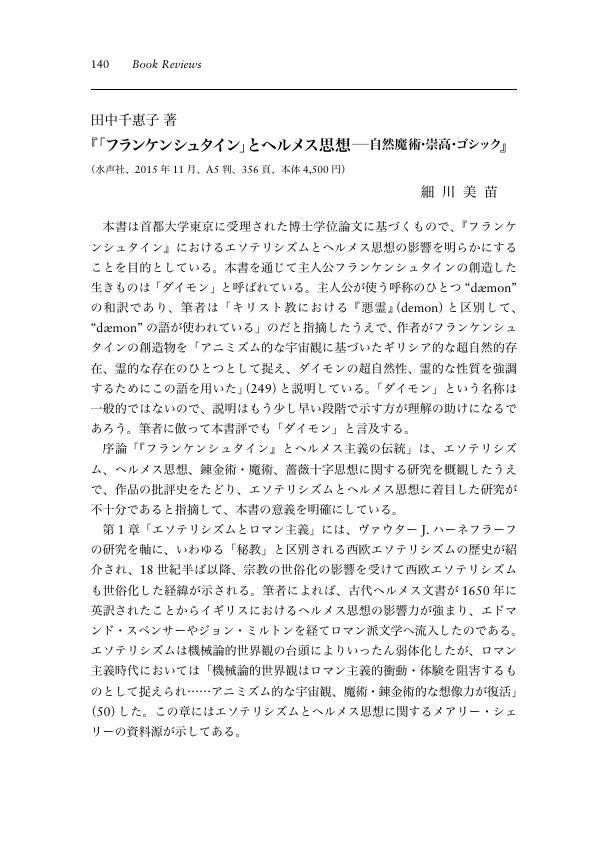- 著者
- 小黒 和子
- 出版者
- イギリス・ロマン派学会
- 雑誌
- イギリス・ロマン派研究 (ISSN:13419676)
- 巻号頁・発行日
- vol.39and40, pp.217-220, 2015-11-30 (Released:2016-12-27)
- 著者
- 園田 暁子 吉川 朗子 笹川 浩
- 出版者
- イギリス・ロマン派学会
- 雑誌
- イギリス・ロマン派研究
- 巻号頁・発行日
- vol.38, pp.67-84, 2014
- 著者
- 兼武 道子
- 出版者
- イギリス・ロマン派学会
- 雑誌
- イギリス・ロマン派研究 (ISSN:13419676)
- 巻号頁・発行日
- vol.38, pp.108-112, 2014
2 0 0 0 『エピサイキディオン』とシェリーの秘儀的読者
- 著者
- 田久保 浩
- 出版者
- イギリス・ロマン派学会
- 雑誌
- イギリス・ロマン派研究 (ISSN:13419676)
- 巻号頁・発行日
- vol.39, pp.67-80, 2015
<p>Frederick Jones suggested in his notes to Shelley's letter to John Gisborne that the poet's own description of <i>Epipsychidion</i> as a mysterious poem written only for the <i>Synetoi</i>, the initiated, was an intentional mystification. In spite of critics who agree with Jones's view considering either Shelley's anxiety about finding an audience for the poem or the need to protect himself from attacks based on misconstrued relationships, it seems worthwhile to see the poem as indeed an "esoteric" poem. </p><p>Shelley always felt like a <i>Synetoi</i> as part of an intellectual minority carrying, like Prometheus, secret wisdom as their only weapon against the powerful and repressive establishment. Shelley's increasing sense of disappointment in finding audience in his later years led him to the idea of poetic tradition in which the best poetic spirit is disseminated across time as he eloquently argued in <i>A Defence of Poetry</i>. He saw himself as participating in that great tradition. <i>Epipsychidion</i> has characteristics as an esoteric text with its assumed distinction between the initiated and the uninitiated. Reading the poem as an exoteric text with ritualistic elements answers a number of questions, including the issues of its elaborate Renaissance style, the ambiguous identity of the "Sweet Spirit," the relevance of the philosophic statement on love to the idealized history of the poet, its concern with poetry and language, the reason for the apparently escapist message of the <i>envoi</i> to get away from the ignorant mass, and finally, the political implications this poem may possibly have. The ideal esoteric audience for Shelley would appreciate the imaginative poetic language of the poem, understand the poetic tradition that celebrates love as exemplified by Dante, and share Shelley's view that the social institution of marriage sustains the sexual discrimination, the property system, and inequality. The poem is supposed to provide a ritual for the purpose of inspiring visionaries to unite and follow the imagination and the love principle so that, despite the adverse time, the tradition of imaginative poetry can be transmitted to future generations.</p>
- 著者
- David CHANDLER
- 出版者
- イギリス・ロマン派学会
- 雑誌
- イギリス・ロマン派研究 (ISSN:13419676)
- 巻号頁・発行日
- vol.44, pp.62-66, 2020-03-30 (Released:2021-04-21)
- 著者
- 小口 一郎 佐藤 光 後藤 美映 仙葉 豊
- 出版者
- イギリス・ロマン派学会
- 雑誌
- イギリス・ロマン派研究 (ISSN:13419676)
- 巻号頁・発行日
- vol.33, pp.125-133, 2009
2 0 0 0 OA アイルランドとロマン主義―「国民国家」と文学―
- 著者
- 及川 和夫 池田 寛子 鈴木 美津子 アルヴィ宮本 なほ子
- 出版者
- イギリス・ロマン派学会
- 雑誌
- イギリス・ロマン派研究 (ISSN:13419676)
- 巻号頁・発行日
- vol.41, pp.41-58, 2017-03-30 (Released:2018-05-09)
2 0 0 0 石幡直樹・佐々木郁子・結城正美・吉川朗子・小田友弥・山内正一著, 『ロマンティック・エコロジーをめぐって』, 英宝社, 2006年12月, 四六判, vii+211頁, 本体1,900円
- 著者
- 金津 和美
- 出版者
- イギリス・ロマン派学会
- 雑誌
- イギリス・ロマン派研究 (ISSN:13419676)
- 巻号頁・発行日
- vol.32, pp.109-113, 2008
1 0 0 0 OA 21世紀のロマン派研究と精読の可能性―「距離」をめぐるいくつかのアプローチ―
- 著者
- 笠原 順路 田代 尚路 志渡岡 理恵 鈴木 喜和 木谷 厳 松島 正一 長尾 輝彦 瀬名波 榮喜 直原 典子 安藤 幸江
- 出版者
- イギリス・ロマン派学会
- 雑誌
- イギリス・ロマン派研究 (ISSN:13419676)
- 巻号頁・発行日
- vol.39and40, pp.151-185, 2015-11-30 (Released:2016-12-27)
1 0 0 0 OA 『フランケンシュタイン』の書簡性
- 著者
- 平倉 菜摘子
- 出版者
- イギリス・ロマン派学会
- 雑誌
- イギリス・ロマン派研究 (ISSN:13419676)
- 巻号頁・発行日
- vol.43, pp.17-29, 2019-03-30 (Released:2020-05-08)
- 参考文献数
- 23
The multilayered narrative of Frankenstein; or, The Modern Prometheus has fascinated both critics and general readers ever since the novel’s first publication in 1818. Their main interests, however, have tended to lie in the narratives of its protagonist, Victor Frankenstein, and his hideous creature, thus overlooking the significance of the outermost layer in the novel: the letters from Robert Walton to his sister, Margaret Saville. According to the British Critic’s 1818 review of Frankenstein, this “sort of introduction, which precedes the main story of the novel” has “nothing else to do with it.” In the present age, Frankenstein is often regarded as the prime example of a fictional work which “shifts from epistolary immediacy to monologic narrative, from eighteenth-century novels of letters to nineteenth-century first person narratives” (Britton 2009). These remarks seem to suggest that the epistolary form was no longer valued in the early nineteenth century. It should be pointed out, however, that Mary Shelley was deeply read in epistolary novels, especially the ones written by her own parents. This essay maintains that Shelley was keenly aware of the fact that she was born into a family of literary geniuses, and that her choice of an epistolary format for her very first work shows her desire to invigorate this slightly outdated mode. It attempts to shed light on her masterly performance of epistolarity, first by closely examining the way in which she created “Letters from the Arctic” à la Letters from Sweden (1796) by her mother, Mary Wollstonecraft. I then try to give a possible answer to the question of why these fictional letters are addressed to “a dear sister in England,” whose own voice is totally silenced. By considering the creation of Margaret Saville, I hope to shed light on the imaginative dialogue between Shelley and her own half-sister, Fanny Wollstonecraft. Lastly, I analyse the “mock epistolarity” (O’Dea 2004) in Frankenstein, hoping to clarify the innovativeness of Shelley’s narrative. I conclude with a brief examination of the voices of women skillfully embedded in this seemingly “unfeminine” epistolary novel.
- 著者
- 山田 崇人
- 出版者
- イギリス・ロマン派学会
- 雑誌
- イギリス・ロマン派研究 (ISSN:13419676)
- 巻号頁・発行日
- vol.38, pp.100-104, 2014-03-20 (Released:2017-01-17)
- 著者
- 門田 守
- 出版者
- イギリス・ロマン派学会
- 雑誌
- イギリス・ロマン派研究 (ISSN:13419676)
- 巻号頁・発行日
- vol.39and40, pp.200-203, 2015-11-30 (Released:2016-12-27)
1 0 0 0 OA ロマン主義とナチュラル・ヒストリー―越境する精神
- 著者
- 川津 雅江 道家 英穂 大田垣 裕子 城戸 光世
- 出版者
- イギリス・ロマン派学会
- 雑誌
- イギリス・ロマン派研究 (ISSN:13419676)
- 巻号頁・発行日
- vol.43, pp.47-65, 2019-03-30 (Released:2020-05-08)
1 0 0 0 OA 田中千惠子 著『「フランケンシュタイン」とヘルメス思想―自然魔術・崇高・ゴシック』
- 著者
- 細川 美苗
- 出版者
- イギリス・ロマン派学会
- 雑誌
- イギリス・ロマン派研究 (ISSN:13419676)
- 巻号頁・発行日
- vol.41, pp.140-143, 2017-03-30 (Released:2018-05-09)
- 著者
- 田吹 長彦
- 出版者
- イギリス・ロマン派学会
- 雑誌
- イギリス・ロマン派研究 (ISSN:13419676)
- 巻号頁・発行日
- vol.38, pp.47-65, 2014-03-20 (Released:2017-01-17)
1 0 0 0 OA 『高慢と偏見』にみる感受性 : 錯誤と精神医学言説
- 著者
- 小川 公代
- 出版者
- イギリス・ロマン派学会
- 雑誌
- イギリス・ロマン派研究 (ISSN:13419676)
- 巻号頁・発行日
- vol.37, pp.19-32, 2013-03-20 (Released:2017-01-17)
This essay aims to examine the relationship between erroneous judgments and the function of sensibility observed in the medical discourse of the late eighteenth century, and to see how it affected Jane Austen's ideas about "pride" and "self-complacency" in her Pride and Prejudice (1813). The novel can be read as a moralistic tale about a young woman who, in gaining new experience in the world, comes to see the virtue and vice of other characters, but it can also be interpreted as a philosophical inquiry into the human mind. Elizabeth Bennet, the heroine, is endowed with a keen perception and acute sensibility which allow her to detect the slightest feelings and intent of others, but the novel also exposes the vulnerability of a feeling woman. Her emotional reaction (such as anger) to events that take place around her frequently blinds her to the truth, and consequently gives rise to erroneous judgments. According to Coleridge, "a man whose moral feelings, reason, understanding, and sense are perfectly sane and vigorous, may yet have been mad." Perhaps sharing the same concern about the unstable and unpredictable nature of the mind, Austen explores the possibility of a "perfectly sane" person having delusions or errors of "fancy" in an ordinary setting. Mrs Bennet's ridiculous remarks about other characters best exemplify this theory. Thomas Arnold's theory of notional insanity and his concept of "fancy" in Observations on the Nature, Kinds, Causes, and Prevention of Insanity, Lunacy, or Madness (1782) is relevant in understanding Mrs Bennet's self-complacency and Jane Bennet's "error of fancy." While Arnold's theory about insanity is based on the Lockean theories of "idea" and "notion" which are more conceptual than corporeal, Alexander Crichton's theory of mind introduced in his An Inquiry into the Nature and Origin of Mental Derangement (1798) has a more corporeal basis which is also shared by the contemporary medical men such as Lavatar, Gall and Spurzheim. The new development of brain science and nerve theory suggested an embodied approach to human subjectivity. It is clear from Austen's frequent mention of "nerves" and "feelings" that she was under the influence of these medical discourses. In these medical texts, bodily sensibility increasingly takes over the functions of reason such as making judgment about the situations s/he encounters or perceiving truths.
1 0 0 0 OA ピクチャレスクのエネルギー―プライス『ピクチャレスク論』を中心に―
- 著者
- 今村 隆男
- 出版者
- イギリス・ロマン派学会
- 雑誌
- イギリス・ロマン派研究 (ISSN:13419676)
- 巻号頁・発行日
- vol.41, pp.1-12, 2017-03-30 (Released:2018-05-09)
- 参考文献数
- 14
In An Essay on the Picturesque: As Compared with the Sublime and the Beautiful; And, on the Use of Studying Pictures, for the Purpose of Improving Real Landscape Uvedale Price claims “the two opposite qualities of roughness, and of sudden variation, joined to that of irregularity” are the most efficient causes of the picturesque landscape. Then he highlights intricacy, wildness, or partial concealment also as key elements, while he says the standard of the picturesque landscape is the art of painting. Here is a strained relationship between those dynamic elements in the scenery and the static and stereotyped expression of picture art. This inconsistency, I contend, is the basis of the picturesque landscape. In An Essay Price describes “hollow lanes and bye roads” under old pollarded trees as a typical picturesque landscape. This is a joint work of nature and humans living in it. This description appears before the definition of the word “picturesque” and is repeated several times in An Essay. This demonstrates its importance for him. In his description of these “hollow lanes” or a ruined building overgrown with weeds Price emphasizes the significance of “accidents and neglect” or “time and accidents” which complete the ideal landscape for him. In these wild scenes he finds energy, or dynamism, of the vegetations, which leads to even a germination of an ecological view on natural power. In the second book of the second edition he tries to convince the reader how the cottage buildings of villagers and the villages themselves have been established for a longer period of “time and accidents.” Price envisions the landscapes of nature and those of human community as being formed through time and space. In the changing period of the 1790s Price was searching a way to describe the surrounding circumstances outside of the conventions.
1 0 0 0 挿絵から見る『四季』 : 落穂拾いのラヴィーニアの表現を中心に
- 著者
- 出羽 尚
- 出版者
- イギリス・ロマン派学会
- 雑誌
- イギリス・ロマン派研究 (ISSN:13419676)
- 巻号頁・発行日
- vol.37, pp.1-18, 2013
The aim of this paper is to investigate illustrations for editions of James Thomson's The Seasons [first compiled edition in 1730] published between 1770s and 1810s. This is because I believe that those illustrations reveal artists' interpretations of The Seasons in the age of Romanticism when the poem was widely accepted. We especially deal with illustrations engraved for the episode of Lavinia in 'Autumn'. She is a lovely woman gleaning in the field of a merciful farmer, Palemon. There are four major types of the illustrations of Lavinia. (1) Lavinia kneeling beside Palemon: They are in the field of Palemon who is asking her origin. (2) Lavinia standing beside Palemon: They are in the field of Palemon who is declaring his love for her. Lavinia is holding gleanings sometimes on her apron and lowering her eyes in embarrassment. (3) Lavinia standing beside her widow mother in front of a hovel: Lavinia is informing her mother about her engagement to Palemon. (4) Lavinia standing alone in the field: She is holding gleanings under her arm or putting them on her head. She sometimes has a scythe or a jug. An important fact about Lavinia's illustrations is that each type derives its visual source from the iconography of Ruth in the Book of Ruth. Ruth is also a female gleaner living with her widow mother. In the end she accepts the merciful marriage proposal of Boaz the farmer. The iconography of Ruth had been repeatedly pictorialized since the thirteenth century and distributed in large quantities especially through the media of prints. Not only did artists of the eighteenth and nineteenth centuries adopt the iconography but they also introduced the merciful story of the Book of Ruth into their illustrations of Thomson's episode. In this respect, artists of the age of Romanticism associated the lines of The Seasons with the biblical story of mercy.
- 著者
- 及川 和夫
- 出版者
- イギリス・ロマン派学会
- 雑誌
- イギリス・ロマン派研究 (ISSN:13419676)
- 巻号頁・発行日
- vol.33, pp.81-92, 2009-03-20 (Released:2017-01-17)
1 0 0 0 OA ロマン派とヴィクトリア朝(第32回(2007年)全国大会シンポージアム要旨)
- 著者
- 森松 健介 和田 綾子 及川 和夫 富士川 義之
- 出版者
- イギリス・ロマン派学会
- 雑誌
- イギリス・ロマン派研究 (ISSN:13419676)
- 巻号頁・発行日
- vol.32, pp.89-103, 2008-03-20 (Released:2017-01-17)








